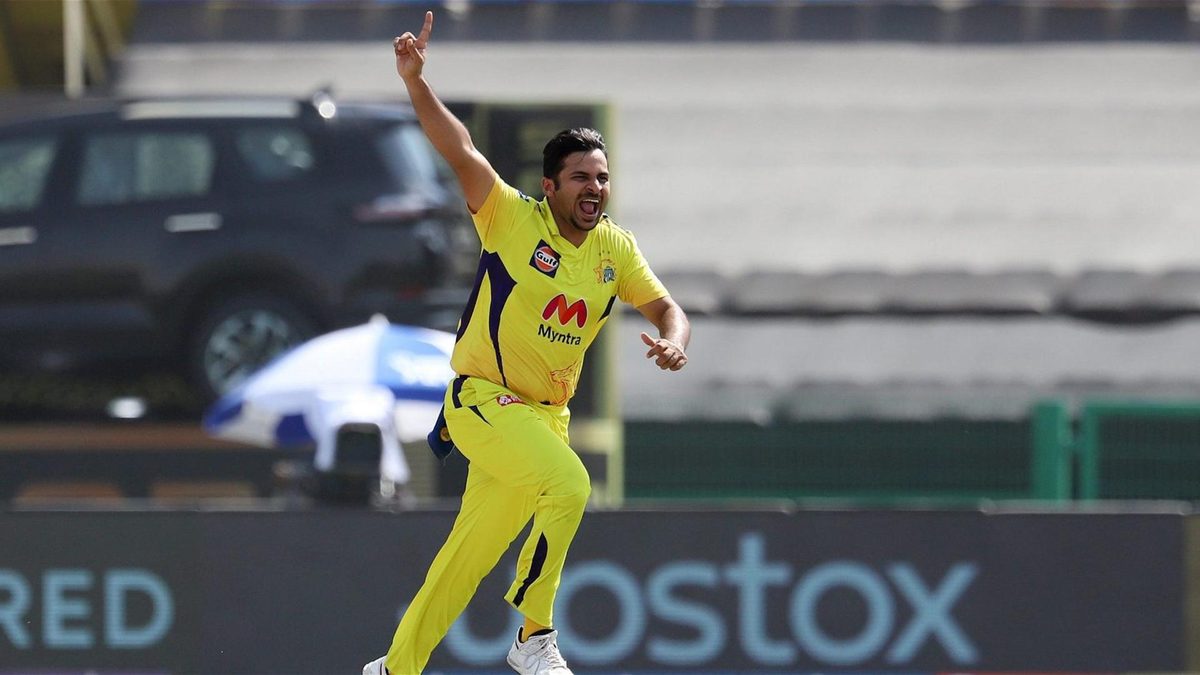
As India gear up for the T20 World Cup, they have been left to sweat on the fitness of Hardik Pandya. It won’t be a bad idea to keep in mind reserves like Shardul Thakur, writes Divy Tripathi
It will have come as a relief to Virat Kohli, Ravi Shastri and Co. when Hardik Pandya showed the first glimpses of batting form in Mumbai Indians’ encounter against Punjab Kings on September 28. The all-rounder averaged less than 10 in IPL 2021 before the knock, but his 30-ball 40*, taking MI home, showed that his famed batting power was only dormant, not disappeared.
However, the performance didn’t dispel all the doubts surrounding him ahead of the T20 World Cup. Hardik is still yet to bowl a ball in IPL 2021 – though he did roll his arm over on India’s tour of Sri Lanka between the two halves of the tournament – and MI bowling coach Shane Bond has kept coy on his fitness. His quality as a white-ball batter should not be in doubt, even if he is somewhat underrated and underutilised. But given the fact that his all-round skills usually serve to balance the side, and therefore unbalance the team if not available, him not bowling keeps the questions around his availability alive.
All-rounders who can contribute to an international standard in both disciplines are a rarity. But in Shardul Thakur, India have a close-ish replacement available.
This is not to say he is a like for like for Hardik. It is obvious that Thakur is not the same calibre of batter as Pandya. The two do not fill in the same roles in their respective IPL teams or at the international level in this discipline. Thakur is a lower-order bat in limited overs game, whereas Pandya is a middle-order option. Pandya’s batting strike-rate is 142.19 in T20s, whereas Thakur has a strike-rate of 115.82.
Based on his batting ability alone, Pandya has secured selection in the IPL and the national setup, while Thakur has never been given the role of a middle-order batter to set up totals or to chase down target. Only once has he batted above 8 in the IPL or in T20Is.
But there is something about Thakur, an ineffable quality that allows him to punch above his weight and rise to the challenge when the pressure is on. His numbers are almost uniformly better in international cricket than in domestic. This was never more clear than at The Oval in August, when a pair of belligerent half-centuries – including the fastest ever at the People’s Ground in Tests – and key breakthroughs with the ball gave India a seismic win.
Thakur has also made match-changing contributions in limited opportunities lower down the order in ODIs, such as his 21-ball 30 against England at Pune. These crucial runs came at a time when Krunal Pandya was struggling to score runs at a brisk pace, and helped India get to a match-winning total. After a scintillating 6-ball 17 against the West Indies in 2019, which helped finish a tricky chase in the 49th over, Thakur said, “I know I have the talent to bat at No. 8. If I can contribute these runs when the team needs me, I would be glad”.
Thakur is quite untested as a batter up the order, but that doesn’t mean he’s incapable. He showed a glimpse of his talent at the domestic level, when batting at number 7 he thrashed a 57-ball 92, which helped Mumbai crush Himachal Pradesh in Vijay Hazare Trophy 2021 by 200-runs.
He has never shied away from expressing himself, and that shows in his T20I strike-rate of 197.14. His very first innings as a T20I batter was an eight-ball 22 run cameo, which played a part in him earning the Player of the Match award. If needed, Ravindra Jadeja can fulfil a role as a makeshift No.6, with Thakur slotting in at No.7. It’s a downgrade in the batting department, but perhaps one made worthwhile by the bowling flexibility it offers.
He cannot become Hardik overnight, but in case there are contingencies needed in the middle of the tournament, or even before it, Thakur is the best man to come in as an all-rounder in a rejigged batting line-up.
Thakur is close to a complete bowler, who has a knack for delivering key breakthroughs for his team. Just as with the bat, he gets his wickets in crucial match situations, something he showed at The Oval by getting Rory Burns and Joe Root, against RCB by getting AB de Villiers and Devdutt Padikkal in the 17th over, putting the brakes on RCB’s efforts, and against KKR by getting Andre Russell before he could unleash his fury. His subtle changes of pace have worked so far for CSK. There’s no reason they shouldn’t work should the Indian setup need it in their World Cup campaign.
So worst comes to the worst, if India are in a fix in the UAE with respect to the fast-bowling all-rounder question, they’ll always have Lord Shardul to bank upon in tough situations.








